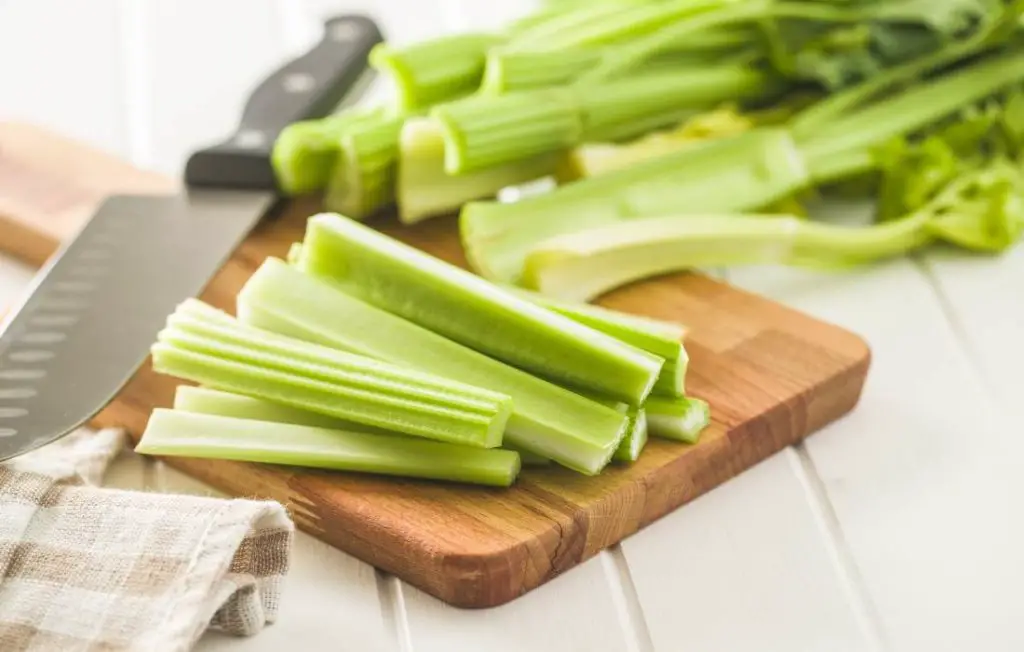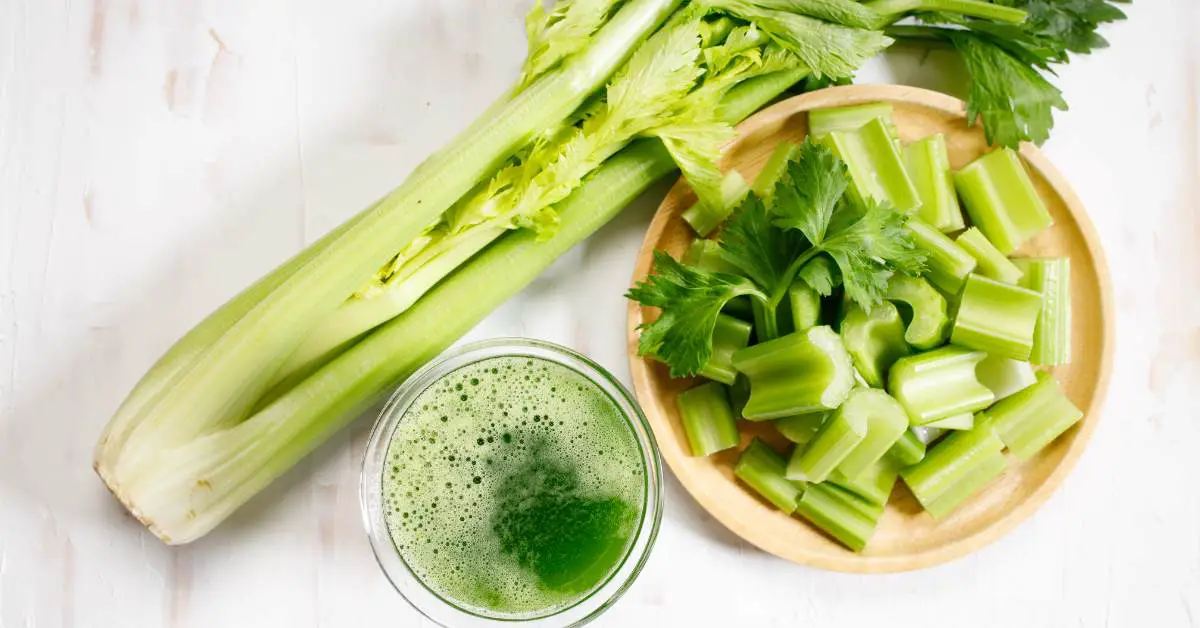Is celery low histamine? Histamine intolerance can feel like a game of health hide-and-seek, where symptoms pop up unexpectedly. Let’s take a closer look at the relationship between histamine intolerance and celery and uncover whether this vegetable is indeed safe to eat on a low-histamine diet.
The simple answer to whether celery is low histamine is yes. Celery is a low-histamine vegetable that has some surprising health benefits. But let’s dig a little deeper and find out whether celery could be beneficial if you have histamine intolerance.
Understanding Histamine Intolerance
Histamine, a natural compound in our bodies, serves roles like managing stomach acid and immune responses. However, histamine intolerance disrupts this balance. If you have histamine intolerance, you have difficulty breaking histamine down, leading to symptoms such as headaches, digestive issues, and skin problems.
With histamine intolerance, your body struggles to regulate histamine properly, causing an array of uncomfortable symptoms.
The Diet-Histamine Interaction
Imagine your body as a theater, with different foods as the actors. Histamine, the director, choreographs bodily functions. When histamine can’t be managed well, histamine intolerance steps onto the stage. Foods can either trigger or mitigate histamine intolerance.
For instance, foods rich in histamine, like aged cheeses and fermented products, can worsen symptoms. Thus, adjusting one’s diet becomes crucial for managing histamine intolerance. But what about celery?

Histamines in Celery
If you enjoy the crunchiness of celery, you’ll be pleased to learn that celery is low histamine and it’s not a significant source of other biogenic amines (1) that could provoke or worsen histamine intolerance symptoms.
Beyond containing little or no histamine or other biogenic amines, celery is also not a histamine liberator, meaning it doesn’t stimulate the release of histamine from mast cells. If you have histamine intolerance, you want to avoid foods that are histamine liberators too.
Could Celery Be Beneficial for Histamine Intolerance?
It’s reassuring that celery lacks biogenic amines that could worsen histamine intolerance, but could it also be beneficial? Celery contains modest amounts of quercetin.
However, celery’s exact quercetin levels per 100 grams remains somewhat of a mystery. One source has its quercetin content listed as “unknown,” which leaves us eager to uncover more about this elusive compound in celery.
Still another source offers a glimpse into the quercetin landscape. It suggests that celery contributes around 2.2% of the average quercetin intake, which translates to roughly 4.43 mg per day. (2)
This might not make celery a quercetin heavyweight, but it’s like a subtle whisper of this beneficial antioxidant.
Quercetin’s Role in Easing Histamine Intolerance Symptoms
Why might quercetin be of benefit if you have histamine intolerance? By stabilizing cell membranes, quercetin helps rein in the histamine production and release, potentially reducing the body’s histamine burden.
Research shows that quercetin can significantly reduce histamine release from mast cells. Imagine quercetin putting a gentle hand on the brakes, slowing down the histamine rush. In a study, when exposed to quercetin, histamine release from nasal scrapings was inhibited by a remarkable 46 to 96 percent. (5)
In essence, quercetin could be a helper for those dealing with histamine intolerance. Its multi-faceted approach – stabilizing cell membranes, inhibiting histamine production and release, and taming histamine’s allergic triggers (3) – makes it a promising contender for managing histamine-related symptoms. However, it’s an area that needs more research.
Quercetin also has anti-inflammatory benefits. That’s important, as many chronic health issues, including cardiovascular disease, autoimmune conditions, and some forms of cancer are fueled by inflammation. (2)
Other Compounds in Celery That Could Benefits Histamine Intolerance
Celery brings a zesty dose of vitamin C to the table, which is nature’s own antihistamine. (6) This mighty vitamin doesn’t just ward off colds – it’s a potent inflammation-fighter and mast cell stabilizer. Think of it as a diplomat negotiating peace between your body and histamine.
By reducing inflammation and giving mast cells a nudge to behave, vitamin C could help prevent the dramatic histamine releases that leave you feeling less than stellar.
Sulforaphane: The Inflammation Whisperer That May Lower Histamine
Ever heard of sulforaphane? It’s celery’s secret weapon that holds anti-inflammatory and antioxidant powers. This compound isn’t afraid to tackle oxidative stress head-on and the fires of inflammation.
By doing so, sulforaphane might just be your ally in keeping histamine in check. A quieter, calmer cellular environment means fewer chances for histamine to stage a noisy rebellion.
While quercetin has been grabbing the spotlight, vitamin C and sulforaphane quietly join the ranks of histamine intolerance defenders in celery. So, celery may offer a symphony of natural compounds working in harmony to ease your histamine woes.
Still, this is an ongoing area of research, and more studies are needed to fully uncover the depth of celery’s potential benefits.

Does Cooking Affect the Histamine Content of Celery?
If you enjoy adding celery to stir-fries or stews, you might wonder whether cooking celery has an impact on its histamine content. Cooking methods can indeed sway histamine levels in certain foods. (4) Research casts a revealing light on the histamine-cooking relationship. Here’s what it shows about various cooking methods:
- Grilling and Frying: These methods can crank up the histamine levels in foods. For instance, grilled seafood can sport higher histamine levels compared to its raw or boiled counterparts. Fried veggies? They might hold more histamine than their raw counterparts.
- Boiling: Boiling doesn’t seem to play a dramatic role in altering histamine levels in most foods. Fermented pastes remained histamine-steady after a good boil.
- Meat and Eggs: Histamine in meat gets a boost from grilling but takes a dip when boiled. Eggs? Well, they seem to play it cool, with cooking methods not drastically impacting their histamine content.
So, what does this mean for our crunchy green friend, celery? While research hasn’t explicitly studied celery’s histamine dance under various cooking techniques, the broader culinary insights suggest a trend.
Cooking methods like grilling and frying tend to pump up histamine levels, while boiling, the mellow approach, often leaves histamine content. Fortunately, most people don’t fry or grill celery.
Exploring Celery’s Role in a Low-Histamine Diet
Is celery low histamine? In unraveling the celery-histamine connection, we find a vegetable that fits well within a low-histamine regimen.
Celery’s natural compounds, like quercetin, vitamin C, and sulforaphane, offer potential benefits by stabilizing cell membranes, reducing histamine release, and taming inflammation.
While cooking’s impact on celery’s histamine content remains a bit of a mystery, broader culinary insights shed light on cooking methods.
Note that research continues to unfold the intricate relationship between this unassuming vegetable and histamine intolerance.
So, whether you munch on it raw or add it to your culinary creations, celery’s potential as a histamine-friendly option adds another layer of choice to those seeking comfort amidst histamine intolerance.
So, enjoy celery, but listen to your body when you eat it and keep a food journal to see how you respond.
References:
- Wójcik W, Łukasiewicz M, Puppel K. Biogenic amines: formation, action and toxicity – a review. J Sci Food Agric. 2021 May;101(7):2634-2640. doi: 10.1002/jsfa.10928. Epub 2020 Dec 12. PMID: 33159318. https://pubmed.ncbi.nlm.nih.gov/33159318/
- Li Y, Yao J, Han C, Yang J, Chaudhry MT, Wang S, Liu H, Yin Y. Quercetin, Inflammation and Immunity. Nutrients. 2016 Mar 15;8(3):167. doi: 10.3390/nu8030167. PMID: 26999194; PMCID: PMC4808895.
- Mlcek J, Jurikova T, Skrovankova S, Sochor J. Quercetin and Its Anti-Allergic Immune Response. Molecules. 2016 May 12;21(5):623. doi: 10.3390/molecules21050623. PMID: 27187333; PMCID: PMC6273625. https://pubmed.ncbi.nlm.nih.gov/27187333/
- Chung BY, Park SY, Byun YS, Son JH, Choi YW, Cho YS, Kim HO, Park CW. Effect of Different Cooking Methods on Histamine Levels in Selected Foods. Ann Dermatol. 2017 Dec;29(6):706-714. doi: 10.5021/ad.2017.29.6.706. Epub 2017 Oct 30. PMID: 29200758; PMCID: PMC5705351.
- Otsuka H, Inaba M, Fujikura T, Kunitomo M. Histochemical and functional characteristics of metachromatic cells in the nasal epithelium in allergic rhinitis: studies of nasal scrapings and their dispersed cells. J Allergy Clin Immunol 1995, Oct;96(4):528-36. https://pubmed.ncbi.nlm.nih.gov/7560665/
- Johnston CS, Martin LJ, Cai X. Antihistamine effect of supplemental ascorbic acid and neutrophil chemotaxis. J Am Coll Nutr. 1992 Apr;11(2):172-6. PMID: 1578094.

